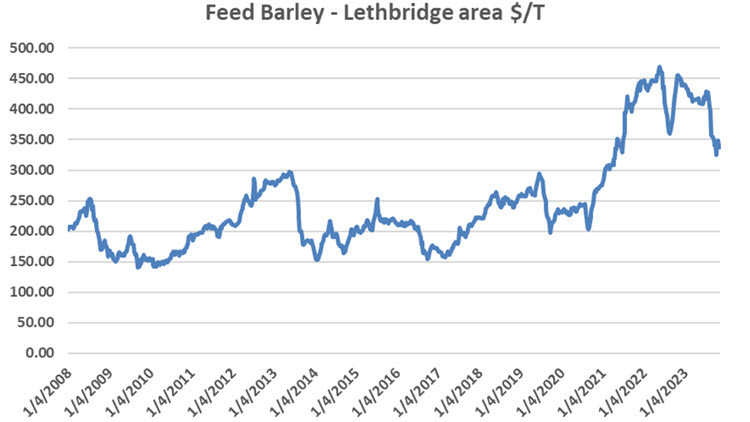Non-urgent government operations are closed December 24 to January 1, reopening January 2. View available services during this period.
See event listings and more articles in this edition of Agri-News: November 20, 2023 issue
“Barley is the feed grain of choice for most Alberta cattle feeders,” says Neil Blue, provincial crops market analyst with the Alberta government. “Other feed grains are used, but if available and price competitive, barley is the major ingredient in cattle finishing rations. Of course, other animals also are fed significant volumes of barley.”
Barley prices rose to record highs in June 2022 following the 2021 drought, retreated during the improved growing conditions of 2022, then rose in late 2022 with the early and cold start to last winter. Feed barley prices have been slipping lower despite the dry conditions across much of Alberta, B.C. and Saskatchewan.
Figure 1. Feed Barley Prices – Lethbridge area $/T

“There are a number of factors which have contributed to the price moderation of feed barley,” says Blue. “During recent years when barley was in relatively short supply and prices rose to those record levels, livestock feeders sought lower cost rations. Milling wheat was even selling as feed wheat to meet feed demand. Oats and other feedgrains were also substituted for part of rations. Unit trains of imported U.S. corn became more common in the Lethbridge area as logistic challenges of those imports were overcome. Feeding imported corn has become common when price competitive.”
In 2022, Australia produced a record grain crop. Then, during 2023, China relaxed its restrictive import tariffs against Australian products that began in 2020 during the early Covid period. During the period that Australia was unable to compete with Canada for crop sales to China, Canadian crop exports to China rose, further tightening Canada’s domestic supplies.
However, Blue points out with that Canadian advantage now gone, Canadian barley exports to early November 2023 total just 592,000 tonnes, compared to 816,000 tonnes at this time last year, and 970,000 tonnes in November 2021.
“Positives for the barley price outlook are that 2023 Canadian barley production was limited by a reduced acreage and lack of moisture,” explains Blue. Statistics Canada estimates the 2023 average barley yield at 55 bushels/acre compared to last year’s 70 bushels/acre. Some post-harvest yield reports came in better than mid-summer expectations, but total Canadian barley supplies are significantly lower than last crop year.
“The shortage of hay for cattle feeding may lead to more straw-grain rations, with barley, oats and pellets the most likely concentrate source. Barley prices have dropped, becoming more competitive with world prices, increasing the prospects of improved barley exports as the crop year progresses. Also, malting barley demand remains firm.
“Meanwhile, the cost of imported U.S. corn is a major factor for feed barley prices, keeping in mind that some feeders prefer feeding barley, even at a premium price to corn. Traditional advice applies to barley marketing this crop year. Know your product, consider your cash flow needs, follow the market situation, and shop widely for the best, financially secure farm gate price,” says Blue.
Contact
Connect with Neil Blue for more information:
Phone: 780-422-4053
Email: [email protected]
Sign up for Agri-News
Start every Monday with the week’s top agricultural stories and latest updates.
Read about all things agriculture at Alberta.ca/agri-news